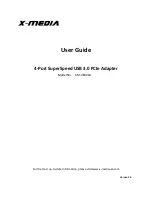
13
THEORY OF OPERATION
TX Voice Path:
Phone line audio from the tone remote controller is fed into the TX voice path in simplex mode through
transformer T1. In 4-wire mode it is fed into transformer T2 and is selected by jumper JP27. Both transformer
circuits have surge suppression and an auto-resettable poly-switch for lightning protection. They each have RF
chokes and RF bypass caps to keep out any RF that may get into the phone lines. For best results an extra Earth
ground connection is provided at J1.
Audio is input through Pin 2 of JP27 through a hi-pass filter C123 and RP13 to block any 60-cycle hum from an
unbalanced phone line. Audio is then passed into TX amp low pass filter U14:3. The low pass filter rolls off noise
above 3 KHz. It’s output is about 1.2 V p-p with -20 dBm low-level guard tone on the phone line.
Pin 2 of JP26 is the input into a bi-quadratic filter U15:2, U15:1, and U15:4. The band pass output is on Pin 7 and
can be peaked using frequency tuning pot RP9. The frequency tuning 25-turn pot RP9 will tune over a range of 1
KHz from 2100 to 3100 Hz. The band pass output on Pin 7 is fed into notch null pot RP10 along with the voice
and Guard Tone through R179 into RP10. The two Guard Tone frequencies are 180 degrees out of phase and
cancel at the input of U15:3. From U15:3’s output the remaining voice is fed into C89. From the other side of C89
it is passed into mixer U14:1 and then output through a high Z or low Z circuit to the base station’s modulator.
RX Voice Path:
RX audio from the base station goes through hi-pass filter C39 and RP3. RP3 also serves as the RX input level
adjustment pot. This audio is then fed into amplifier U8:2 which acts as low pass filter for noise above 3 KHz and
if jumper SJ15 is installed it can give a 6 dB per octave de-emphasis if desired.
Audio from U8:2 is fed to C56. From there it passes through the notch filter to remove 2175 Hz voice components.
This circuit works in exactly the same way as the description for the TX Voice Path. Voice audio from the notch
filter is input into the audio mixer U8:4. The mixer audio is then input into the line amplifier (U20:3) which drives
T1. The line amplifier has an enable transistor that is controlled by the microprocessor. The micro can respond to
the COR carrier input and enable this amplifier if necessary or desirable via programming.
Signaling Path:
Signaling audio from T1 or T2 passes through the TX amp U14:3. Tone remote audio from input level pot RP13 is
fed into the Guard Tone state variable band pass filter and into the broadband function tone detector circuit via
U10:3. The Guard Tone frequency is normally 2175 Hz, and the high Q state variable filter has a 6 dB bandwidth
of about + or – 70 Hz. It is then fed into the Guard Tone detector U11:3 and Schmitt Trigger U10:1 and level
shifter Q23 to the microprocessor for frequency validation. Once it has been validated and checked for the proper
timing, the microprocessor then looks at the function tone output from Q22 and performs the monitor or frequency
function following the high-level Guard Tone command. U10:2 is a high gain amp for the function tone followed by
Schmidt trigger U10:4.
Power Supply:
13-18 VDC is input on the red wire of the Radio Interface connector and then into RF inductor L7 into an auto-
resettable polyswitch. D22 is a polarity protection diode that is designed to pop the resettable fuse if power is
hooked up backwards. C31 and C34 act as RF bypass caps after the RF inductor L7. U6 acts as a 12 VDC
regulator. Its output is fed to all of the analog circuitry and U14:2 acts a pseudo-ground reference at
approximately 6 VDC. The 12 VDC on the analog page schematic is also fed over to U4 which is a 5 VDC
regulator shown on the digital page to run the microprocessor and the optional encoders/decodes and serial
chips. The relays on the digital page receive their 12 VDC from the 12 VDC regulator. They are driven by open-
collector transistors to protect the microprocessor from the 12 VDC.








































